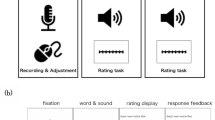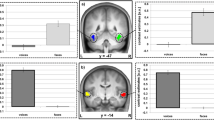Abstract
The human voice contains in its acoustic structure a wealth of information on the speaker's identity and emotional state which we perceive with remarkable ease and accuracy1,2,3. Although the perception of speaker-related features of voice plays a major role in human communication, little is known about its neural basis4,5,6,7. Here we show, using functional magnetic resonance imaging in human volunteers, that voice-selective regions can be found bilaterally along the upper bank of the superior temporal sulcus (STS). These regions showed greater neuronal activity when subjects listened passively to vocal sounds, whether speech or non-speech, than to non-vocal environmental sounds. Central STS regions also displayed a high degree of selectivity by responding significantly more to vocal sounds than to matched control stimuli, including scrambled voices and amplitude-modulated noise. Moreover, their response to stimuli degraded by frequency filtering paralleled the subjects' behavioural performance in voice-perception tasks that used these stimuli. The voice-selective areas in the STS may represent the counterpart of the face-selective areas in human visual cortex8,9; their existence sheds new light on the functional architecture of the human auditory cortex.
This is a preview of subscription content, access via your institution
Access options
Subscribe to this journal
Receive 51 print issues and online access
$199.00 per year
only $3.90 per issue
Buy this article
- Purchase on SpringerLink
- Instant access to full article PDF
Prices may be subject to local taxes which are calculated during checkout



Similar content being viewed by others
References
Doehring, D. G. & Bartholomeus, B. N. Laterality effect in voice recognition. Neuropsychologia 9, 425–430 (1971).
Papcun, G., Kreiman, J. & Davis, A. Long-term memory for unfamiliar voices. J. Acoust. Soc. Am. 85, 913–925 (1989).
Van Dommelen, W. A. Acoustic parameters in human speaker recognition. Lang. Speech 33(3), 259–272 ( 1990).
Assal, G., Aubert, C. & Buttet, J. Asymétrie cérébrale et reconnaissance de la voix. Rev. Neurol. 137, 255– 268 (1981).
Van Lancker, D. R. & Canter, G. J. Impariment of voice and face recognition in patients with hemispheric damage. Brain Cogn. 1, 185–195 ( 1982).
Van Lancker, D. R., Kreiman, J. & Cummings, J. Voice perception deficits: Neuroanatomical correlates of phonagnosia. J. Clin. Exp. Neuropsychol. 11, 665–674 (1989).
Imaizumi, S. Vocal identification of speaker and emotion activates different brain regions. NeuroReport 8, 2809–2812 (1997).
Kanwisher, N., McDermott, J. & Chun, M. M. The fusiform face area: a module in human extrastriate cortex specialized for face perception. J. Neurosci. 17, 4302–4311 (1997).
McCarthy, G., Puce, A., Gore, J. C. & Allison, T. Face-specific processing in the human fusiform gyrus. J. Cogn. Neurosci. 9, 605–610 (1997).
Klatt, D. H. & Klatt, L. C. Analysis, synthesis, and perception of voice quality variations among female and male talkers. J. Acoust. Soc. Am. 87, 820–857 ( 1990).
Zatorre, R. J., Evans, A. C., Meyer, E. & Gjedde, A. Lateralization of phonetic and pitch discrimination in speech processing. Science 256, 846–849 ( 1992).
Dehaene, S. et al. Anatomical variability in the cortical representation of first and second language. NeuroReport 8, 3809 –3815 (1997).
Binder, J. R., Frost, J. A. & Bellgowan, P. S. F. Superior temporal sulcus (STS) responses to speech and nonspeech auditory stimuli. J. Cogn. Neurosci. 11 (Suppl. 1), 99 (1999).
Seltzer, B. & Pandya, D. N. Afferent connections and architectonics of the superior temporal sulcus and surrounding cortex in the rhesus monkey. Brain Res. 149, 1–24 (1978).
Pandya, D. N. Anatomy of the auditory cortex. Rev. Neurol 151, 486–494 (1995).
Jones, E. G., Dell’Anna, M. E., Molinari, M., Rausell, E. & Hashikawa, T. Subdivisions of macaque monkey auditory cortex revealed by calcium-binding protein immunoreactivity. J. Comp. Neurol. 362, 153–170 (1995).
Rauschecker, J. P. Parallel processing in the auditory cortex of primates. Audiol. Neuro-Otol. 3, 86–103 ( 1998).
Kaas, J. H., Hackett, T. A. & Tramo, M. J. Auditory processing in primate cerebral cortex. Curr. Opin. Neurobiol. 9, 154–170 (1999).
Mesulam, M. M. From sensation to cognition. Brain 121, 1013–1052 (1998).
Ellis, A. W. in Handbook of Research on Face Processing (eds Young, A. W. & Ellis, H. D.) 207–215 (Elsevier, Amsterdam, 1989).
Watzlawick, P., Beavin, J. H. & Jackson, D. D. in A Study of Interactional Patterns, Pathologies and Paradoxes (Norton, New York, 1967).
Rendall, D., Owren, M. J. & Rodman, P. S. The role of vocal trace filtering in identity cueing in rhesus monkey (Macaca mulatta) vocalizations. J. Acoust. Soc. Am. 103, 602–614 ( 1998).
Belin, P., Zatorre, R. J., Hoge, R., Pike, B. & Evans, A. C. Event-related fMRI of the auditory cortex. NeuroImage 10, 417–429 ( 1999).
Hall, D. et al. “Sparse” temporal sampling in auditory fMRI. Hum. Brain Map 7, 213–223 (1999).
Talairach, J. & Tournoux, P. Co-Planar Stereotaxic Atlas of the Human Brain (Thieme, New York, 1988).
Collins, D. L., Neelin, P., Peters, T. M. & Evans, A. C. Automatic 3D intersubject registration of MR volumetric data in standardized Talairach space. J. Comput. Assist. Tomogr. 18, 192–205 (1994).
Turner, R. & Jezzard, P. in Functional Neuroimaging Technical Foundations (eds Thatcher, R. W., Hallett, M., Zeffiro, T., John, E. R. & Huerta, M.) 69–78 (Academic, San Diego, 1994).
Worsley, K. J., Evans, A. C., Marrett, S. & Neelin, P. A three-dimensional statistical analysis for CBF activation studies in human brain. J. Cereb. Blood Flow Metab. 12, 900 –918 (1992).
Acknowledgements
We thank S. Milot, P. Bermudez, M. Bouffard, C. Hurst, A. Cormier, G. Leroux, V. Petre and J. Fiedsend for assistance in data acquisition and analysis, T. Paus, A. Evans, M.-H. Grosbras, I. Lussier, J. Hillenbrand, R. Hoge, G. Legoualher, M.-C. Masure, P. Neelin, K. Worsley and Y. Samson for advice, and N. Kanwisher for seminal discussion. This work was supported by France-Télécom, MRC (Canada), McDonnel-Pew, INSERM-FRSQ and NSERC.
Author information
Authors and Affiliations
Corresponding author
Rights and permissions
About this article
Cite this article
Belin, P., Zatorre, R., Lafaille, P. et al. Voice-selective areas in human auditory cortex. Nature 403, 309–312 (2000). https://doi.org/10.1038/35002078
Received:
Accepted:
Issue Date:
DOI: https://doi.org/10.1038/35002078
This article is cited by
-
Evaluation of perception of music, environmental sounds, and speech in right versus left cerebral stroke patients
The Egyptian Journal of Otolaryngology (2023)
-
Adult attention-deficit/hyperactivity disorder traits in healthy adults associated with brain volumetric data identify precuneus involvement in traffic crashes
Scientific Reports (2023)
-
Intermediate acoustic-to-semantic representations link behavioral and neural responses to natural sounds
Nature Neuroscience (2023)
-
Apperceptive and Associative Forms of Phonagnosia
Current Neurology and Neuroscience Reports (2023)
-
Sounds Pleasantness Ratings in Autism: Interaction Between Social Information and Acoustical Noise Level
Journal of Autism and Developmental Disorders (2023)



